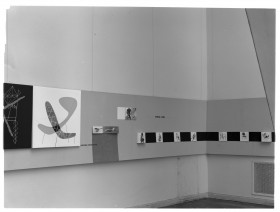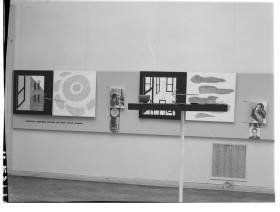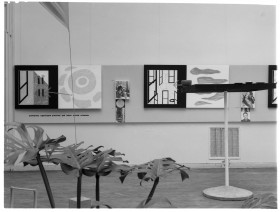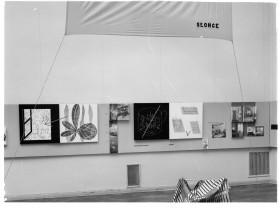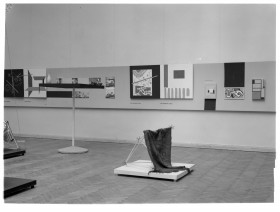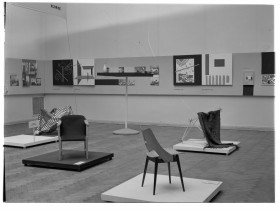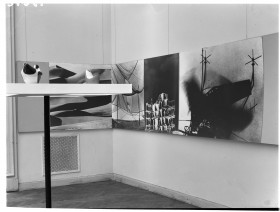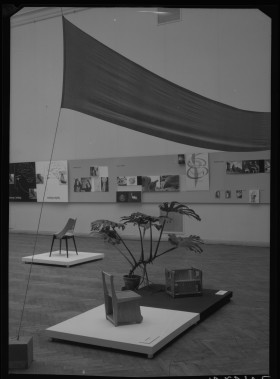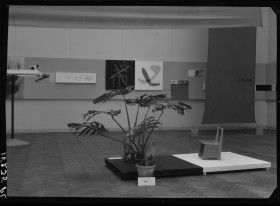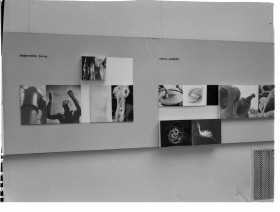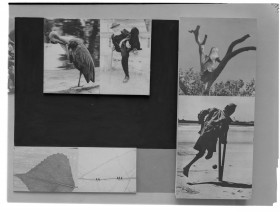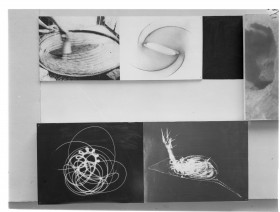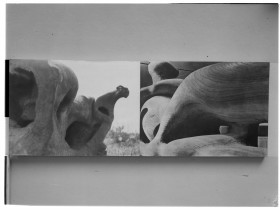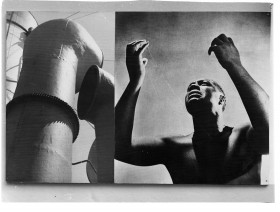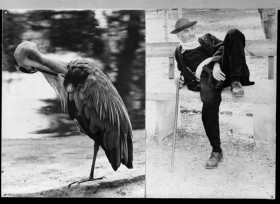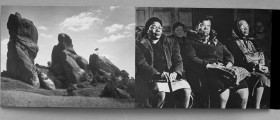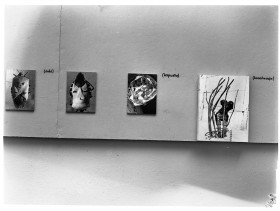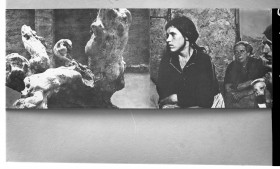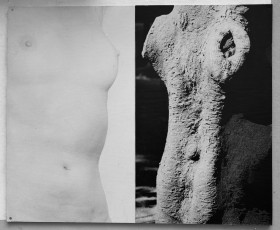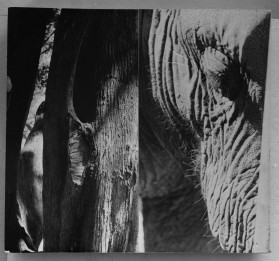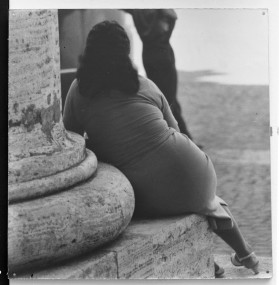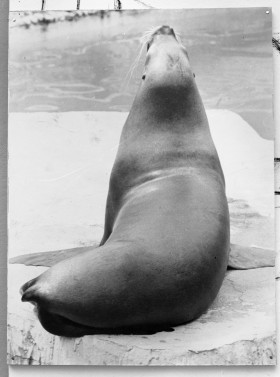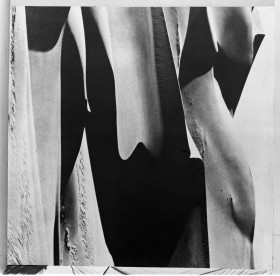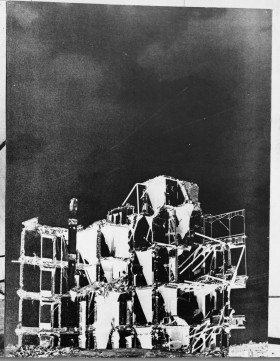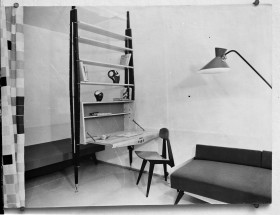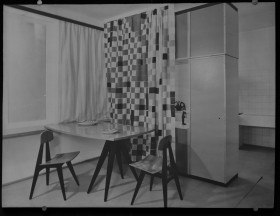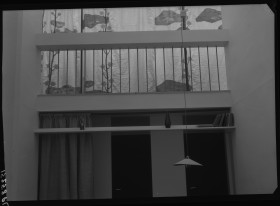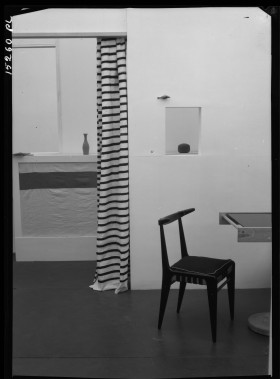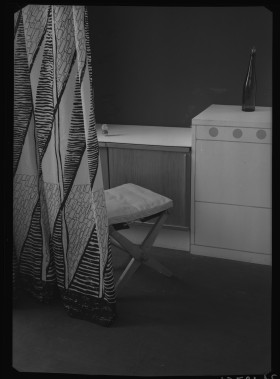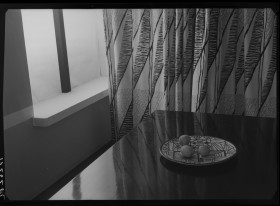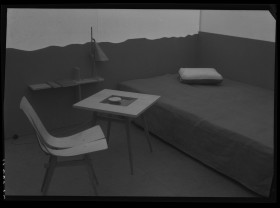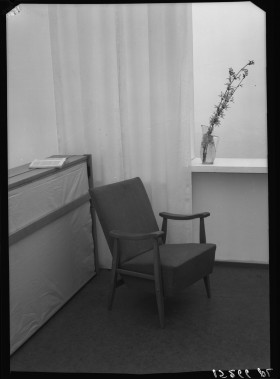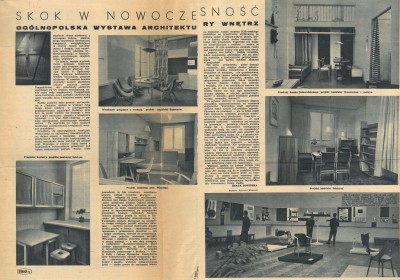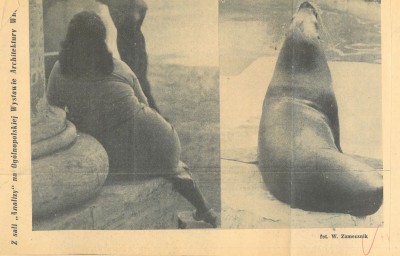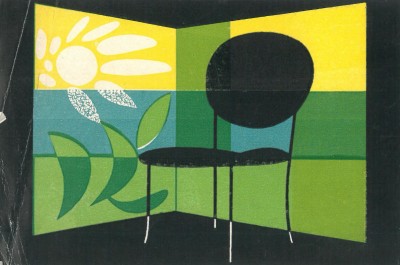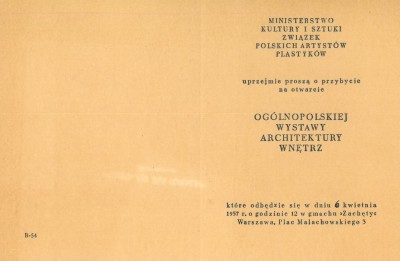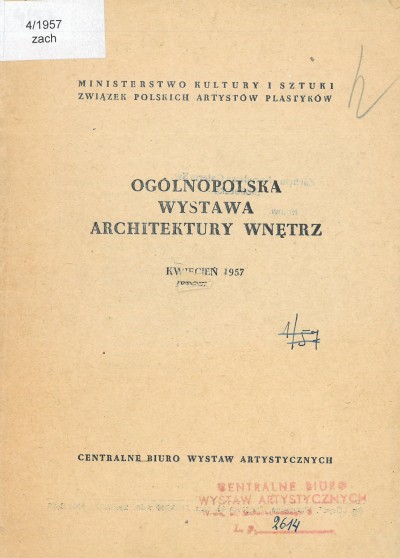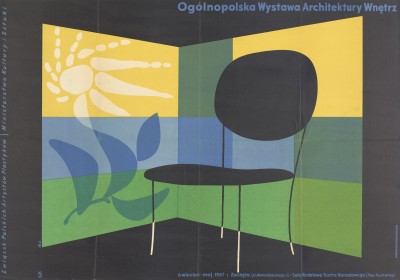2nd Nationwide Interior Design Exhibition
06.04 – 05.05.1957 2nd Nationwide Interior Design Exhibition
Zachęta Central Bureau of Art Exhibitions (CBWA)
exhibition organiser: Association of Polish Artists and Designers (ZPAP) and the Ministry of Culture and Art
commissioner: Olgierd Szlekys
head exhibition designers: Oskar Hansen, Zofia Hansen with the cooperation of Krzysztof Meissner
graphic design: Stanisław Zamecznik
number of works: 685 (including 215 at Zachęta — in the interior design equipment section,
65 in the furniture section, 94 in the textile section, 223 in the ceramics and glass section, 88 in the jewellery and toys section)
attendance: 67,000 (including 15,000 in the Sale Redutowe)
Preparations for the 2nd National Exhibition of Interior Design and Decorative Art (previously 2nd OWAW; the latter part of the original name was later abandoned), initiated in 1953, formally began in January 1954 with the establishment of the Organising Committee.[i] Compared to the first edition of the exhibition, the decision was made to place greater emphasis on taking up ‘problems of contemporary interior design, which aims to best meet the needs of the broad masses’ (which manifested in, among others, including in the organisational works institutions that were not involved in the 1st OWAW, such as the Institute of Industrial Design, Institute of Residential Construction and the Institute of Urban Design and Architecture).[ii]
There were plans to located the exhibitions in one of the new housing estates or in the halls of the reconstructed Arsenal. The basic material for the exhibition came from the competition for the design of residential interiors announced in September 1954. The canvas was a two-room flat for three people in a typical layout used by the Workers’ Housing Estates Department (ZOR).[iii] On 15 March 1955, a jury composed of members of the Association of Polish Artists and Designers (ZPAP) and the Association of Polish Architects (SARP), under the leadership of Wojciech Jastrzębski, awarded ten prizes in three categories.[iv] Even before the competition was concluded, it was finally decided to place the 2nd OWAW at Zachęta and in the Sale Redutowe of the National Theatre, and to entrust the exhibition design to Oskar Hansen.
The exhibition was officially opened by Deputy Minister of Culture and Art Edward Marzec in the presence of ZPAP President Jan Cybis and SARP President Jerzy Hryniewiecki. The main part of the exhibition, referred to as ‘problematic’, was located at Zachęta. In front of the building was a spatial ‘symbolic and propaganda decoration’ designed by Wojciech Zamecznik and a large pyropicture, The Iron Age, by Helena and Roman Husarski.[v] Inside, the introductory part of the exhibition was the ‘analysis room’ (located in the Narutowicz Room). Hansen and Zamecznik arranged it as an installation consisting of graphic boards, arranged into the Associating Thought frieze, starting with the board ‘I look ≠ I see, I see = I think”, hanging blue, green and yellow fabrics symbolising air, greenery and the sun, respectively, as well as several pieces of furniture, fabrics and ceramics. The whole was supposed to be ‘an attempt to analyse the issues concerning the shaping of the interior space’.
Further on the first floor there were ‘synthesis rooms’, which were filled with life-size mock-ups of the competition interiors, located in free-standing cubicles — wooden frames covered with canvas. Viewers could look inside through openings — masked windows and doors, as well as separate cut-outs. Apart from the mock-ups, there were boards with supplementary materials on the walls and floor. Apart from competition entries presenting solutions for typical ZOR flats, a fragment of an individually designed terraced house (designed by Zbigniew Ihnatowicz, Jerzy Sołtan, Włodzimierz Wittek) was also presented. In the middle of one of the rooms, Hansen’s ‘sculptural study of architectural space’ was set up; the room also included reduced-size boards with designs and photographs of interiors that were not mocked-up.
On the main floor, there was a presentation of wall-mounted mock-ups of interiors consisting of furniture designed at the Institute of Industrial Design and commercially available furniture.
The part of the exhibition in the Sale Redutowe was called ‘interior objects’ and included sections for furniture, fabric, ceramics, as well as jewellery and toys. The last part of the exhibition was described as ‘interiors in the city’. It included the interiors of the Adam Mickiewicz Museum of Literature, as well as stained glass windows for the Mausoleum of Struggle and Martyrdom in Aleja Szucha.
Organised in the Thaw atmosphere of social and cultural life, the exhibition became a major event. On the one hand, it was a demonstration of an exceptionally attractive presentation of a new, comprehensive way of thinking about the aesthetics of a flat, built on the heritage of modernism, with particular emphasis on Le Corbusier’s mature work. An important role was played here by the expressive set design and the skilfully formulated exhibition programme. Thanks to them, in the opinions of reviewers, the exhibition clearly dominated over the 1st OWAW. No less important was the signalling of the possibility of reconciling new interior design ideas with the spatial and economic limitations typical for Poland. The issue of improving the broadly understood housing conditions of the population aroused general interest. The housing programme of Władysław Gomułka’s administration, which was still being formulated at the time, based on cooperative construction, raised hopes for an immediate improvement of the difficult living conditions of a significant part of the Polish population.
Attendance at the 2nd OWAW more than doubled the average number of viewers at other exhibitions at the time, and the numerous opinions in the memorial book spoke to the emotional investment of the visitors. Although the number of press texts decreased by about a third in comparison to the first edition of the exhibition, it is noticeable that they were on average much longer than those of five years prior, which can be read as a decrease in the ritualisation of the circulation of information in publications and a greater emphasis on evaluation statements (even if Józef Grabowski complained about the superficiality of journalistic voices in the catalogue). The basic tone of the statements was favourable to the exhibition, with critical voices primarily concerned with the commercial unavailability of the majority of the objects displayed. Among the exceptions was the brutality with which Bożena Kowalska (appreciating the aesthetic quality and didactic dimension) criticised the overly-aesthetic spirit of the exhibition: ‘What of it, when you cannot buy any of the furniture or various objects seen at the exhibition in any state stores, unless you take the road of close connections and large bribes. What of it, when the most common problem is not what to buy but what to buy it with, and not how to furnish a flat but how and where to find a flat [emphasis — BK]’.[vi]
The organisers were aware of the fundamental importance of moving the exhibition projects into production and — more broadly — the cooperation of artists with manufacturing companies. Therefore, the 2nd OWAW was complemented by a two-day conference of artists with representatives of the furniture industry and trade. Additionally, a relatively large prize pool, obtained from the Ministry of Culture and Art and several other ministries, was turned into not only nearly 50 prizes for artists, but also into 9 awards for ‘good technical workmanship’ of the exhibits.[vii]
It should be noted that in spite of the national character, the exhibition in question was — even to a slightly greater degree than the 1st OWAW — dominated by the residents of Warsaw, with nearly 70% of the exhibitors coming from it; the second was the Łódź district, with 11% share of the artists. One artist from abroad (Krystyna Dydyńska-Henneberg) appeared only symbolically. Therefore, the National Salon of Interior Design, which took place in May and June 1958 in Kraków, should be treated as an important and complementary event to the 2nd OWAW.
Marek Czapelski
Institute of Art History of the University of Warsaw
This compilation was prepared as part of the National Programme for the Development of Humanities of the Polish Minister of Science and Higher Education — research project The History of Exhibitions at Zachęta — Central Bureau of Art Exhibitions in 1949–1970 (no. 0086/NPRH3/H11/82/2016) conducted by the Institute of Art History of the University of Warsaw in collaboration with Zachęta — National Gallery of Art.
Bibliography:
Catalogues:
- Ogólnopolska wystawa architektury wnętrz, April 1957, introduction: Józef Grabowski. Warsaw: Centralne Biuro Wystaw Artystycznych, 1957
- Grabowski, Józef. Ogólnopolska wystawa architektury wnętrz 1957. Warsaw: Centralne Biuro Wystaw Artystycznych, 1958
Source texts:
- A. B. ‘Wystawa architektury wnętrz’. Przemysł Drzewny, no. 8, 1957
- Cieślikowski, Jerzy. ‘Mieszkanie w szufladzie’. Nowe Sygnały, no. 16, 1957
- Czartoryska, Urszula. ‘W poszukiwaniu „małych wesołych rzeczy”’. Tygodnik Zachodni, no. 18, 1957
- ds. ‘Sztuka dnia powszedniego’. Gazeta Robotnicza, no. 95, 1957
- dw. ‘Jak moglibyśmy mieszkać, gdyby.. . . .’. Głos Pracy, no. 82, 1957
- dw. ‘Zamiast sprawozdania. Po naradzie w „Zachęcie”’. Głos Pracy, no. 98, 1957
- E. Ga. ‘Ogólnopolska wystawa architektury wnętrz’. Trybuna Ludu, no. 96, 1957
- Garztecka, Ewa. ‘Od naczyń glinianych do mebli z „Ładu”’. Sztandar Młodych, no. 18, 1957
- grt. ‘Czego nie masz i nie dostaniesz — to zobaczysz na Wystawie Architektury Wnętrz’. Express Wieczorny, no. 82, 1957
- Hansen, Oskar. ‘Kilka uwag o mieszkaniu’. Przegląd Kulturalny, no. 18, 1957
- Hansen, Oskar. ‘Towards Open Form / Ku Formie Otwartej’. Warsaw, 2005, p. 188
- Huml, Irena. ‘Polska sztuka stosowana w XX wieku’. Warsaw, 1978, pp. 185–189
- Gola, Jola, ed. Jerzy Sołtan. Monografia, Warsaw, 1995, pp. 182–183
- Jal. ‘Jak mieszkać. Wrażenia z wystawy architektury wnętrz’. Express Ilustrowany, no. 106, 1957
- Kowalska, Bożena. ‘Rzeczywistość czy wizja’. Pomorze, no. 7, 1957
- Ledóchowski, Stanisław. ‘Opowiadamy się za nowoczesnością’. Słowo Powszechne, no. 93, 1957
- Łojak, Grzegorz. ‘Plastycy a producenci mebli’. Żołnierz Wolności, no. 134, 1957
- ‘Podjęliśmy tę próbę . . . Z Profesorem Oskarem Hansenem rozmawia Wojciech Lipowicz’, in Użytkowa fantastyka lat pięćdziesiątych, exh. cat. Poznań: Muzeum Rzemiosł Artystycznych — Oddział Muzeum Narodowego, 1991, pp. 54–55
- ‘Polska architektura wnętrz’. Tygodnik Powszechny, no. 21, 1957
- Putowska, Jadwiga. ‘Wnętrza i sztuka stosowana’. Architektura, no. 4, 1958
- Rago, Danuta. ‘Ogólnopolska wystawa architektury wnętrz’. Sztandar Młodych, no. 88, 1957
- Sowińska, Beata. ‘Skok w nowoczesność’. Stolica, no. 17, 1957
- Wojciechowski, Aleksander. ‘Niektóre sprawy polskiej architektury wnętrz’. Projekt, no. 3, 1957
- Wojciechowski Aleksander. ‘O wystawie architektury wnętrz’. Przegląd Kulturalny, no. 18, 1957
- ‘Z ogólnopolskiej wystawy architektury wnętrz’. Przegląd Kulturalny, no. 15, 1957
Online sources:
muzeum.asp.waw.pl/collective/pawtucket/index.php (accessed 8 April 2019)
[i] The history of the organisation of the exhibition is discussed in detail by Józef Grabowski in the catalogue, which was actually a souvenir from the exhibition (Ogólnopolska wystawa architektury wnętrz 1957, ed. Józef Grabowski, Warsaw: Centralne Biuro Wystaw Artystycznych, 1958). He also lists the spiritus movens of the undertaking: Zbigniew Szuszkiewicz from the Ministry of Culture and Art, MKiS, Oskar Hansen from the Academy of Fine Arts, and Olgierd Szlekys from the Interior Design section of ZPAP. The Organising Committee was chaired by Wojciech Jastrzębowski, who was replaced in the final stage of preparations by Lucjan Kintopf. Ferdynand Drabik was appointed as the exhibition commissioner, and in 1956, after his resignation, the position was taken over by Olgierd Szlekys.
[ii] Citation from the exhibition regulations, formulated by Hansen, after Grabowski.
[iii] I.e. the main investor in mass construction.
[iv] Prizes for two-room interiors were awarded to: Władysław Wincze, Zofia and Oskar Hansen, Henryk Marconi and Alicja Wirth, and Czesław Łączka. Prizes for ‘growing’ interiors were awarded to Jan Kurzątkowski, Olgierd Szlekys and Stanisław Kucharski. Three prizes for developing better interior alternatives: a team composed of Zofia Antosiak, Jan Kosiński, Krzysztof Meisner and Włodzimierz Wittek; Zofia and Oskar Hansen, and Czesław Łączka.
[v] The exhibition in the public space was additionally advertised by four-sided stands with posters in nearby Teatralny and today’s Piłsudskiego Squares.
[vi] Bożena Kowalska, ‘Rzeczywistość czy wizja’, Pomorze, no. 7, 1957, p. 5.
[vii] All winners are listed in Ogólnopolska wystawa . . ., pp. 34–36
2nd Nationwide Interior Design Exhibition
06.04 – 05.05.1957
Zachęta Central Bureau of Art Exhibitions (CBWA)
pl. Małachowskiego 3, 00-916 Warsaw
See on the map
Thank you for your registration!
We have sent to your email address a link with a confirmation of registration.
Please click on the link in order to fully activate your account.
After registering on the service, you can add events and exhibitions that are important for you to your favourites. To your list of favourites you can also add objects from the collection, and from amongst the publications and multimedia library which we make available on our open Creative Commons licence. As a result you can download publications, books, films and many other materials.
Shortly you will be redirected to main page
